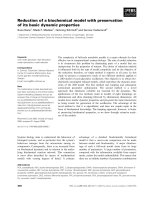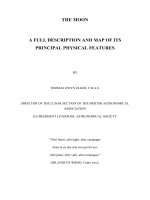THE MOON A FULL DESCRIPTION AND MAP OF ITS PRINCIPAL PHYSICAL FEATURES doc
Bạn đang xem bản rút gọn của tài liệu. Xem và tải ngay bản đầy đủ của tài liệu tại đây (770.63 KB, 338 trang )
THE MOON
A FULL DESCRIPTION AND MAP OF ITS
PRINCIPAL PHYSICAL FEATURES
BY
THOMAS GWYN ELGER, F.R.A.S.
DIRECTOR OF THE LUNAR SECTION OF THE BRITISH ASTRONOMICAL
ASSOCIATION
EX-PRESIDENT LIVERPOOL ASTRONOMICAL SOCIETY
"Altri fiumi, altri laghi, altre campagne
Sono la su che non son qui tra noi,
Altri piani, altre valli, altre montagne."
ORLANDO FURIOSO, Canto xxxii.
LONDON GEORGE PHILIP & SON,
32 FLEET STREET, E.C.
LIVERPOOL: 45 TO 51 SOUTH CASTLE STREET
1895
PREFACE
This book and the accompanying map is chiefly intended for the use of
lunar observers, but it is hoped it may be acceptable to many who, though
they cannot strictly be thus described, take a general interest in
astronomy.
The increasing number of those who possess astronomical telescopes, and
devote more or less of their leisure in following some particular line of
research, is shown by the great success in recent years of societies,
such as the British Astronomical Association with its several branches,
the Astronomical Society of the Pacific, and similar institutions in
various parts of the world. These societies are not only doing much in
popularising the sublimest of the sciences, but are the means of
developing and organising the capabilities of their members by
discouraging aimless and desultory observations, and by pointing out how
individual effort may be utilised and made of permanent value in almost
every department of astronomy.
The work of the astronomer, like that of the votary of almost every other
science, is becoming every year more and more specialised; and among its
manifold subdivisions, the study of the physical features of the moon is
undoubtedly increasing in popularity and importance. To those who are
pursuing such observations, it is believed that this book will be a
useful companion to the telescope, and convenient for reference.
Great care has been taken in the preparation of the map, which, so far as
the positions of the various objects represented are concerned, is based
on the last edition of Beer and Madler's chart, and on the more recent
and much larger and elaborate map of Schmidt; while as regards the shape
and details of most of the formations, the author's drawings and a large
number of photographs have been utilised. Even on so small a scale as
eighteen inches to the moon's diameter, more detail might have been
inserted, but this, at the expense of distinctness, would have detracted
from the value of the map for handy reference in the usually dim light of
the observatory, without adding to its utility in other ways. Every named
formation is prominently shown; and most other features of interest,
including the principal rill-systems, are represented, though, as regards
these, no attempt is made to indicate all their manifold details and
ramifications, which, to do effectually, would in very many instances
require a map on a much larger scale than any that has yet appeared.
The insertion of meridian lines and parallels of latitude at every ten
degrees, and the substitution of names for reference numbers, will add to
the usefulness of the map.
With respect to the text, a large proportion of the objects in the
Catalogue and in the Appendix have been observed and drawn by the author
many times during the last thirty years, and described in _The
Observatory_ and other publications. He has had, besides, the advantage
of consulting excellent sketches by Mr W.H. MAW, F.R.A.S., Dr. SHELDON,
F.R.A.S., Mr. A. MEE, F.R.A.S., Mr. G.P. HALLOWES, F.R.A.S., Dr. SMART,
F.R.A.S., Mr. T. GORDON, F.R.A.S., Mr. G.T. DAVIS, Herr BRENNER, Herr
KRIEGER, Mr. H. CORDER, and other members of the British Astronomical
Association. Through the courtesy of Professor HOLDEN, Director of the
Lick Observatory, and M. PRINZ, of the Royal Observatory of Brussels,
many beautiful photographs and direct photographic enlargements have been
available, as have also the exquisite heliogravures received by the
author from Dr. L. WEINEK, Director of the Imperial Observatory of
Prague, and the admirable examples of the photographic work of MM. PAUL
and PROSPER HENRY of the Paris Observatory, which are occasionally
published in _Knowledge_. The numerous representations of lunar objects
which have appeared from time to time in that storehouse of astronomical
information, _The English Mechanic_, and the invaluable notes in
"Celestial Objects for Common Telescopes," and in various periodicals, by
the late REV. PREBENDARY WEBB, to whom Selenography and Astronomy
generally owe so much, have also been consulted.
As a rule, all the more prominent and important features are described,
though very frequently interesting details are referred to which, from
their minuteness, could not be shown in the map. The measurements (given
in round numbers) are derived in most instances from NEISON'S (Nevill)
"Moon," though occasionally those in the introduction to Schmidt's chart
are adopted.
THOMAS GYWN ELGER.
BEDFORD, 1895.
CONTENTS
INTRODUCTION
MARIA, OR PLAINS, TERMED "SEAS"
RIDGES
RING-MOUNTAINS, CRATERS, &C.
Walled Plains
Mountain Rings
Ring-Plains
Craters
Crater Cones
Craterlets, Crater Pits
MOUNTAIN RANGES, ISOLATED MOUNTAINS, &c.
CLEFTS, OR RILLS
FAULTS
VALLEYS
BRIGHT RAY-SYSTEMS
THE MOON'S ALBEDO, SURFACE BRIGHTNESS, &c.
TEMPERATURE OF THE MOON'S SURFACE
LUNAR OBSERVATION
PROGRESS OF SELENOGRAPHY, LUNAR PHOTOGRAPHY
CATALOGUE OF LUNAR FORMATIONS
FIRST QUADRANT
West Longitude 90 deg. to 60 deg.
West Longitude 60 deg. to 40 deg.
West Longitude 40 deg. to 20 deg.
West Longitude 20 deg. to 0 deg.
SECOND QUADRANT
East Longitude 0 deg. to 20 deg.
East Longitude 20 deg. to 40 deg.
East Longitude 40 deg. to 60 deg.
East Longitude 60 deg. to 90 deg.
THIRD QUADRANT
East Longitude 0 deg. to 20 deg.
East Longitude 20 deg. to 40 deg.
East Longitude 40 deg. to 60 deg.
East Longitude 60 deg. to 90 deg.
FOURTH QUADRANT
West Longitude 90 deg. to 60 deg.
West Longitude 60 deg. to 40 deg.
West Longitude 40 deg. to 20 deg.
West Longitude 20 deg. to 0 deg.
MAP OF THE MOON
First Quadrant
Second Quadrant
Third Quadrant
Fourth Quadrant
APPENDIX
Description of Map
List of the Maria, or Grey Plains, termed "Seas," &c.
List of some of the most Prominent Mountain Ranges, Promontories,
Isolated Mountains, and Remarkable Hills
List of the Principal Ray-Systems, Light-Surrounded Craters, and
Light Spots
Position of the Lunar Terminator
Lunar Elements
Alphabetical List of Formations
INTRODUCTION
We know, both by tradition and published records, that from the earliest
times the faint grey and light spots which diversify the face of our
satellite excited the wonder and stimulated the curiosity of mankind,
giving rise to suppositions more or less crude and erroneous as to their
actual nature and significance. It is true that Anaxagoras, five
centuries before our era, and probably other philosophers preceding him,
certainly Plutarch at a much later date taught that these delicate
markings and differences of tint, obvious to every one with normal
vision, point to the existence of hills and valleys on her surface; the
latter maintaining that the irregularities of outline presented by the
"terminator," or line of demarcation between the illumined and
unillumined portion of her spherical superficies, are due to mountains
and their shadows; but more than fifteen centuries elapsed before the
truth of this sagacious conjecture was unquestionably demonstrated.
Selenography, as a branch of observational astronomy, dates from the
spring of 1609, when Galileo directed his "optic tube" to the moon, and
in the following year, in the _Sidereus Nuncius_, or "the Intelligencer
of the Stars," gave to an astonished and incredulous world an account of
the unsuspected marvels it revealed. In this remarkable little book we
have the first attempt to represent the telescopic aspect of the moon's
visible surface in the five rude woodcuts representing the curious
features he perceived thereon, whose form and arrangement, he tells us,
reminded him of the "ocelli" on the feathers of a peacock's tail, a
quaint but not altogether inappropriate simile to describe the appearance
of groups of the larger ring-mountains partially illuminated by the sun,
when seen in a small telescope.
The bright and dusky areas, so obvious to the unaided sight, were found
by Galileo to be due to a very manifest difference in the character of
the lunar surface, a large portion of the northern hemisphere, and no
inconsiderable part of the south-eastern quadrant, being seen to consist
of large grey monotonous tracts, often bordered by lofty mountains, while
the remainder of the superficies was much more conspicuously brilliant,
and, moreover, included by far the greater number of those curious ring-
mountains and other extraordinary features whose remarkable aspect and
peculiar arrangement first attracted his attention. Struck by the analogy
which these contrasted regions present to the land and water surfaces of
our globe, he suspected that the former are represented on the moon by
the brighter and more rugged, and the latter by the smoother and more
level areas; a view, however, which Kepler more distinctly formulated in
the dictum, "Do maculas esse Maria, do lucidas esse terras." Besides
making a rude lunar chart, he estimated the heights of some of the ring-
mountains by measuring the distance from the terminator of their bright
summit peaks, when they were either coming into or passing out of
sunlight; and though his method was incapable of accuracy, and his
results consequently untrustworthy, it served to demonstrate the immense
altitude of these circumvallations, and to show how greatly they exceed
any mountains on the earth if the relative dimensions of the two globes
are taken into consideration.
Before the close of the century when selenography first became possible,
Hevel of Dantzig, Scheiner, Langrenus (cosmographer to the King of
Spain), Riccioli, the Jesuit astronomer of Bologna, and Dominic Cassini,
the celebrated French astronomer, greatly extended the knowledge of the
moon's surface, and published drawings of various phases, and charts,
which, though very rude and incomplete, were a clear advance upon what
Galileo, with his inferior optical means, had been able to accomplish.
Langrenus, and after him Hevel, gave distinctive names to the various
formations, mainly derived from terrestrial physical features, for which
Riccioli subsequently substituted those of philosophers, mathematicians,
and other celebrities; and Cassini determined by actual measurement the
relative position of many of the principal objects on the disc, thus
laying the foundation of an accurate system of lunar topography; while
the labours of T. Mayer and Schroter in the last century, and of
Lohrmann, Madler, Neison (Nevill), Schmidt, and other observers in the
present, have been mainly devoted to the study of the minuter detail of
the moon and its physical characteristics.
As was manifest to the earliest telescopic observers, its visible surface
is clearly divisible into strongly contrasted areas, differing both in
colour and structural character. Somewhat less than half of what we see
of it consists of comparatively level dark tracts, some of them very many
thousands of square miles in extent, the monotony of whose dusky
superficies is often unrelieved for great distances by any prominent
object; while the remainder, everywhere manifestly brighter, is not only
more rugged and uneven, but is covered to a much greater extent with
numbers of quasi-circular formations, differing widely in size, classed
as walled-plains, ring-plains, craters, craterlets, crater-cones, &c.
(the latter bearing a great outward resemblance to some terrestrial
volcanoes), and mountain ranges of vast proportions, isolated hills, and
other features.
Though nothing resembling sheets of water, either of small or large
extent, have ever been detected on the surface, the superficial
resemblance, in small telescopes, of the large grey tracts to the
appearance which we may suppose our terrestrial lakes and oceans would
present to an observer on the moon, naturally induced the early
selenographers to term them Maria, or "seas" a convenient name, which
is still maintained, without, however, implying that these areas, as we
now see them, are, or ever were, covered with water. Some, however,
regard them as old sea-beds, from which every trace of fluid, owing to
some unknown cause, has vanished, and that the folds and wrinkles, the
ridges, swellings, and other peculiarities of structure observed upon
them, represent some of the results of alluvial action. It is, of course,
possible, and even probable, that at a remote epoch in the evolution of
our satellite these lower regions were occupied by water, but that their
surface, as it now appears, is actually this old sea-bottom, seems to be
less likely than that it represents the consolidated crust of some semi-
fluid or viscous material (possibly of a basaltic type) which has welled
forth from orifices or rents communicating with the interior, and
overspread and partially filled up these immense hollows, more or less
overwhelming and destroying many formations which stood upon them before
this catastrophe took place. Though this, like many other speculations of
a similar character relating to lunar "geology," must remain, at least
for the present, as a mere hypothesis; indications of this partial
destruction by some agency or other is almost everywhere apparent in
those formations which border the so-called seas, as, for example,
Fracastorius in the Mare Nectaris; Le Monnier in the Mare Serenitatis;
Pitatus and Hesiodus, on the south side of the Mare Nubium; Doppelmayer
in the Mare Humorum, and in many other situations; while no observer can
fail to notice innumerable instances of more or less complete
obliteration and ruin among objects within these areas, in the form of
obscure rings (mere scars on the surface), dusky craters, circular
arrangements of isolated hills, reminding one of the monoliths of a
Druidical temple; all of which we are justified in concluding were at one
time formations of a normal type. It has been held by some selenologists
and Schmidt appears to be of the number, that, seeing the comparative
scarcity of large ring-plains and other massive formations on the Maria,
these grey plains represent, as it were, a picture of the primitive
surface of the moon before it was disturbed by the operations of interior
forces; but this view affords no explanation of the undoubted existence
of the relics of an earlier lunar world beneath their smooth superficies.
MARIA Leaving, however, these considerations for a more particular
description of the Maria, it is clearly impossible, in referring to their
level relatively to the higher and brighter land surface of the moon, to
appeal to any hypsometrical standard. All that is known in this respect
is, that they are invariably lower than the latter, and that some sink to
a greater depth than others, or, in other words, that they do not all
form a part of the same sphere. Though they are more or less of a
greyish-slaty hue some of them approximating very closely to that of the
pigment known as "Payne's grey" the tone, of course, depends upon the
angle at which the solar rays impinge on that particular portion of the
surface under observation. Speaking generally, they are, as would follow
from optical considerations, conspicuously darker when viewed near the
terminator, or when the sun is either rising or setting upon them, than
under a more vertical angle of illumination. But even when it is possible
to compare their colour by eye-estimation under similar solar altitudes,
it is found that not only are some of the Maria, as a whole, notably
darker than others, but nearly all of them exhibit _local_ inequalities
of hue, which, under good atmospheric and instrumental conditions, are
especially remarkable. Under such circumstances I have frequently seen
the surface, in many places covered with minute glittering points of
light, shining with a silvery lustre, intermingled with darker spots and
a network of streaks far too delicate and ethereal to represent in a
drawing. In addition to these contrasts and differences in the sombre
tone of these extended plains, many observers have remarked traces of a
yellow or green tint on the surface of some of them. For example, the
Mare Imbrium and the Mare Frigoris appear under certain conditions to be
of a dirty yellow-green hue, the central parts of the Mare Humorum dusky
green, and part of the Mare Serenitatis and the Mare Crisium light green,
while the Palus Somnii has been noted a golden-brown yellow. To these may
be added the district round Taruntius in the Mare Foecunditatis, and
portions of other regions referred to in the catalogue, where I have
remarked a very decided sepia colour under a low sun. It has been
attempted to account for these phenomena by supposing the existence of
some kind of vegetation; but as this involves the presence of an
atmosphere, the idea hardly finds favour at the present time, though
perhaps the possibility of plant growth in the low-lying districts, where
a gaseous medium may prevail, is not altogether so chimerical a notion as
to be unworthy of consideration. Nasmyth and others suggest that these
tints may be due to broad expanses of coloured volcanic material, an
hypothesis which, if we believe the Maria to be overspread with such
matter, and knowing how it varies in colour in terrestrial volcanic
regions, is more probable than the first. Anyway, whether we consider
these appearances to be objective, or, after all, only due to purely
physiological causes, they undoubtedly merit closer study and
investigation than they have hitherto received.
There are twenty-three of these dusky areas which have received
distinctive names; seventeen of them are wholly, or in great part,
confined to the northern, and to the south-eastern quarter of the
southern hemisphere the south-western quadrant being to a great extent
devoid of them. By far the largest is the vast Oceanus Procellarum,
extending from a high northern latitude to beyond latitude 10 deg. in the
south-eastern quadrant, and, according to Schmidt, with its bays and
inflections, occupying an area of nearly two million square miles, or
more than that of all the remaining Maria put together. Next in order of
size come the Mare Nubium, of about one-fifth the superficies, covering a
large portion of the south-eastern quadrant, and extending considerably
north of the equator, and the Mare Imbrium, wholly confined to the
northeastern quadrant, and including an area of about 340,000 square
miles. These are by far the largest lunar "seas." The Mare Foecunditatis,
in the western hemisphere, the greater part of it lying in the south-
western quadrant, is scarcely half so big as the Mare Imbrium; while the
Maria Serenitatis and Tranquilitatis, about equal in area (the former
situated wholly north of the equator, and the latter only partially
extending south of it), are still smaller. The arctic Mare Frigoris, some
100,000 square miles in extent, is the only remaining large sea, the
rest, such as the Mare Vaporum, the Sinus Medii, the Mare Crisium, the
Mare Humorum, and the Mare Humboldtianum, are of comparatively small
dimensions, the Mare Crisium not greatly exceeding 70,000 square miles,
the Mare Humorum (about the size of England) 50,000 square miles, while
the Mare Humboldtianum, according to Schmidt, includes only about 42,000
square miles, an area which is approached by some formations not classed
with the Maria. This distinction, speaking generally, prevails among the
Maria, those of larger size, such as the Oceanus Procellarum, the Mare
Nubium, and the Mare Foecunditatis, are less definitely enclosed, and,
like terrestrial oceans, communicate with one another; while their
borders, or, if the term may be allowed, their coast-line, is often
comparatively low and ill-defined, exhibiting many inlets and
irregularities in outline. Others, again, of considerable area, as, for
example, the Mare Serenitatis and the Mare Imbrium, are bounded more or
less completely by curved borders, consisting of towering mountain
ranges, descending with a very steep escarpment to their surface: thus in
form and other characteristics they resemble immense wall-surrounded
plains. Among the best examples of enclosed Maria is the Mare Crisium,
which is considered by Neison to be the deepest of all, and the Mare
Humboldtianum.
Though these great plains are described as level, this term must only be
taken in a comparative sense. No one who observes them when their surface
is thrown into relief by the oblique rays of the rising or setting sun
can fail to remark many low bubble-shaped swellings with gently rounded
outlines, shallow trough-like hollows, and, in the majority of them, long
sinuous ridges, either running concentrically with their borders or
traversing them from side to side. Though none of these features are of
any great altitude or depth, some of the ridges are as much as 700 feet
in height, and probably in many instances the other elevations often rise
to 150 feet or more above the low-lying parts of the plains on which they
stand. Hence we may say that the Maria are only level in the sense that
many districts in the English Midland counties are level, and not that
their surface is absolutely flat. The same may be said as to their
apparent smoothness, which, as is evident when they are viewed close to
the terminator, is an expression needing qualification, for under these
conditions they often appear to be covered with wrinkles, flexures, and
little asperities, which, to be visible at all, must be of considerable
size. In fact, were it possible to examine them from a distance of a few
miles, instead of from a standpoint which, under the most favourable
circumstances, cannot be reckoned at less than 300, and this through an
interposed aerial medium always more or less perturbed, they would
probably be described as rugged and uneven, as some modern lava sheets.
RIDGES Among the Maria which exhibit the most remarkable arrangement of
ridges is the Mare Humorum, in the south-eastern quadrant. Here, if it be
observed under a rising sun, a number of these objects will be seen
extending from the region north of the ring-mountain Vitello in long
undulating lines, roughly concentric with the western border of the
"sea," and gradually diminishing in altitude as they spread out, with
many ramifications, to a distance of 200 miles or more towards the north.
At this stage of illumination they are strikingly beautiful in a good
telescope, reminding one of the ripple-marks left by the tide on a soft
sandy beach. Like most other objects of their class, they are very
evanescent, gradually disappearing as the sun rises higher in the lunar
firmament, and ultimately leaving nothing to indicate their presence
beyond here and there a ghostly streak or vein of a somewhat lighter hue
than that of the neighbouring surface. The Mare Nectaris, again, in the
south-western quadrant, presents some fine examples of concentric ridges,
which are seen to the best advantage when the morning sun is rising on
Rosse, a prominent crater north of Fracastorius. This "sea" is evidently
concave in cross-section, the central portion being considerably lower
than the margin, and these ridges appear to mark the successive stages of
the change of level from the coast-line to the centre. They suggest the
"caving in" of the surface, similar to that observed on a frozen pond or
river, where the "cat's ice" at the edge, through the sinking of the
water beneath, is rent and tilted to a greater or less degree. The Mare
Serenitatis and the Mare Imbrium, in the northern hemisphere, are also
remarkable for the number of these peculiar features. They are very
plentifully distributed round the margin and in other parts of the
former, which includes besides one of the longest and loftiest on the
moon's visible surface the great serpentine ridge, first drawn and
described nearly a hundred years ago by the famous selenographer,
Schroter of Lilienthal. Originating at a little crater under the north-
east wall of great ring-plain Posidonius, it follows a winding course
across the Mare toward the south, throwing out many minor branches, and
ultimately dies out under a great rocky promontory the Promontory
Acherusia, at the western termination of the Haemus range. A
comparatively low power serves to show the curious structural character
of this immense ridge, which appears to consist of a number of
corrugations and folds massed together, rising in places, according to
Neison, to a height of 700 feet and more. The Mare Imbrium also affords
an example of a ridge, which, though shorter, is nearly as prominent, in
that which runs from the bright little ring-plain Piazzi Smyth towards
the west side of Plato. The region round Timocharis and other quarters of
the Mare are likewise traversed by very noteworthy features of a similar
class. The Oceanus Procellarum also presents good instances of ridges in
the marvellous ramifications round Encke, Kepler, and Marius, and in the
region north of Aristarchus and Herodotus. Perhaps the most perfect
examples of surface swellings are those in the Mare Tranquilitatis, a
little east of the ring-plain Arago, where there are two nearly equal
circular mounds, at least ten miles in diameter, resembling tumuli seen
from above. Similar, but more irregular, objects of a like kind are very
plentiful in many other quarters.
It is a suggestive peculiarity of many of the lunar ridges, both on the
Maria and elsewhere, that they are very generally found in association
with craters of every size. Illustrations of this fact occur almost
everywhere. Frequently small craters are found on the summits of these
elevations, but more often on their flanks and near their base. Where a
ridge suddenly changes its direction, a crater of some prominence
generally marks the point, often forming a node, or crossing-place of
other ridges, which thus appear to radiate from it as a centre. Sometimes
they intrude within the smaller ring-mountains, passing through gaps in
their walls as, for example, in the cases of Madler, Lassell, &c. Various
hypotheses have been advanced to account for them. The late Professor
Phillips, the geologist, who devoted much attention to the telescopic
examination of the physical features of the moon, compared the lunar
ridges to long, low, undulating mounds, of somewhat doubtful origin,
called "kames" in Scotland, and "eskers" in Ireland, where on the low
central plain they are commonly found in the form of extended banks
(mainly of gravel), with more or less steep sides, rising to heights of
from 20 to 70 feet. They are sometimes only a few yards wide at the top,
while in other places they spread out into large humps, having circular
or oval cavities on their summits, 50 or 60 yards across, and as much as
40 feet deep. Like the lunar ridges, they throw out branches and exhibit
many breaches of continuity. By some geologists they are supposed to
represent old submarine banks formed by tidal currents, like harbour
bars, and by others to be glacial deposits; in either case, to be either
directly or indirectly due to alluvial action. Their outward resemblance
to some of the ridges on the moon is unquestionable; and if we could
believe that the Maria, as we now see them, are dried-up sea-beds, it
might be concluded that these ridges had a similar origin; but their
close connection with centres of volcanic disturbance, and the numbers of
little craters on or near their track, point to the supposition that they
consist rather of material exuded from long-extending fissures in the
crust of the "seas," and in other surfaces where they are superimposed.
This conjecture is rendered still more probable by the fact that we
sometimes find the direction of clefts (which are undoubted surface
cracks) prolonged in the form of long narrow ridges or of rows of little
hillocks. We are, however, not bound to assume that all the manifold
corrugations observed on the lunar plains are due to one and the same
cause; indeed, it is clear that some are merely the outward indications
of sudden drops in the surface, as in the case of the ridges round the
western margin of the Mare Nectaris, and in other situations, where
subsidence is manifested by features assuming the outward aspect of
ordinary ridges, but which are in reality of a very different structural
character.
The Maria, like almost every other part of the visible surface, abound in
craters of a minute type, which are scattered here and there without any
apparent law or ascertained principle of arrangement. Seeing how
imperfect is our acquaintance with even the larger objects of this class,
it is rash to insist on the antiquity or permanence of such diminutive
objects, or to dogmatise about the cessation of lunar activity in
connection with features where the volcanic history of our globe, if it
is of any value as an analogue, teaches us it is most likely to prevail.
Most observers will agree with Schmidt, that observations and drawings of
objects on the sombre depressed plains of the moon are easier and
pleasanter to make than on the dazzling highlands, and that the lunar
"sea" is to the working selenographer like an oasis in the desert to the
traveller a relief in this case, however, not to an exhausted body, but
to a weary eye.
RING-MOUNTAINS, CRATERS, &C It is these objects, in their almost
endless variety and bewildering number, which, more than any others, give
to our satellite that marvellous appearance in the telescope which since
the days of Galileo has never failed to evoke the astonishment of the
beholder. However familiar we may be with the lunar surface, we can never
gaze on these extraordinary formations, whether massed together
apparently in inextricable confusion, or standing in isolated grandeur,
like Copernicus, on the grey surface of the plains, without experiencing,
in a scarcely diminished degree, the same sensation of wonder and
admiration with which they were beheld for the first time. Although the
attempt to bring all these _bizarre_ forms under a rigid scheme of
classification has not been wholly successful, their structural
peculiarities, the hypsometrical relation between their interior and the
surrounding district, their size, and the character of their
circumvallation, the dimensions of their cavernous opening as compared
with that of the more or less truncated conical mass of matter
surrounding it, all afford a basis for grouping them under distinctive
titles, that are not only convenient to the selenographer, but which
undoubtedly represent, as a rule, actual diversities in their origin and
physical character.
These distinguishing titles, as adopted by Schroter, Lohrmann, and
Madler, and accepted by subsequent observers, are WALLED-PLAINS, MOUNTAIN
RINGS, RING-PLAINS, CRATERS, CRATER-CONES, CRATERLETS, CRATER-
PITS,
DEPRESSIONS.
WALLED-PLAINS These formations, approximating more or less to the
circular form, though frequently deviating considerably from it, are
among the largest enclosures on the moon. They vary from upwards of 150
to 60 miles or under in diameter, and are often encircled by a complex
rampart of considerable breadth, rising in some instances to a height of









